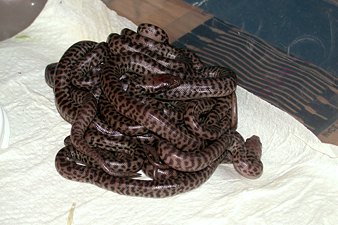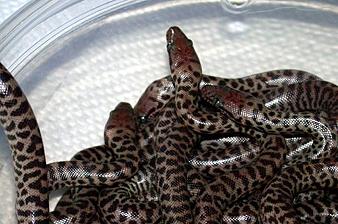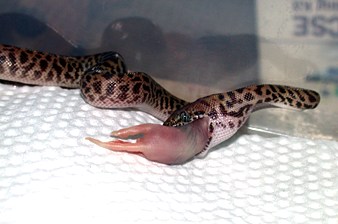Antaresia pythons hatchlings

Antaresia pythons hatchling are pretty small snakes. Some people describe them as little 'worms' or 'noodles' ! LOL
There is nothing really 'worm-like' about them. They are very active and cute sharply patterned minatures of their parents.
A lot of little baby snakes, including pythons, are quite aggressive at first. This does not mean they are just nasty snakes by nature.
Such highly allert behaviour at this stage is to ensure their survival. As there are probably only 2 or 3 snakes form a clutch to survive to adulthood
in nature, you can imagine that the 'surviving of the fittest' rule plays a big role here.
It takes 1 to 3 days for the Children's pythons to hatch - this is leave the eggs completely. They will usually stay in the egg for a day or two after
sticking their heads out and absorb the reminder of the egg yolk during this time.
You should wait
until they come out of the shells by themselves. If some of the babies still have the reminder of the egg yolk attached to their bellies,
just move them gently to to babies enclosure and leave them there in moist environment until the reminder of the sack gets
completely absorbed. Never pull it off - they will bleed and most likely die.
After removing the babies from the incubator, it is a good practice to keep all babies together in a container on moist paper (the proper heat gradient should be
also applied right away). They will usually stick together as a group, like in the photo below (I'd assume for safety and warmth).

The pythons above were born after 44 days of incubation on the 28th of April 2007, (eggs laid on March 15). They are about 7 grams each.
The setup for newborn babies is simple - a small plastic conainer with a small water dish and few paper towels (used by the snakes as hiding spaces) is
all they need. The temperature gradient should be a bit on the high end of what is provided for adults (apparently it is easier to start them feeding
this way (perhaps higher temperatures stimulate higher metabolism rate). Hatchlings can be kept together at first, keeping the cool end at about 85
Fahrenheit to 95 at the hot end. Some people reported their babies start eating when the temperatures rose to 100 - 105, but I wouldn't
push the envelope too far.

The babies shed after 7 to 10 days after being born (moist the towels daily to help them get rid of the old skin).
It will last another week or two, and the first feeding attempt can be made
3 to 4 weeks after they have been born. I offer them a newborn pinky mice. I try a dead one at first (F/T - frozen/thawed), and then live ones
to the reluctunt starters.
After feeding aggressively for a few months, you can graduate to larger pinkies and eventually fuzzies. Once stareted feeding,
they usually easily switch to F/T mice.
The baby antaresia snakes calm down with time. All of them are one of the calmest snakes out there,
very easy going and a pleasure to handle.
Most people will acquire baby pythons already feeding and established, which would make the snakes at least 2 months old (it is the job of a responsible
breeder to make sure his/snakes are settled and feed regurarily before offering them for sale).



The Antaresia babies are small snakes. The appropriate starter food for them in captivity are new born mice ('pinkies'). Since their
food at this stage in nature are small geckos and othe tiny lizards or amphibians, some of the babies can be not interested in mice. They have to
be tricked into eating mice by washing away all the rodent scent. It is also better to feed them dead pinkies instead of live - apparently the movement
of the live mouse can scare the little snake and stop feeding. A good practice is to scent the pinkies with a bit of gecko smell, using the shed skin
for that. Some people reported starting stubborn Antaresia babies on stripes of chicken leg skin (remember? - chickens are descendents of the dinasours!).
Ok, now we have the baby started, eating and doing well. The enclosure setup for them is simple: a small plastic Rubbermaid box with holes for ventilation,
paper towel as substrate, papertowel as hiding and a water bowl. There has to be also the temperature gradient available to the snake for thermoregulation, as with
all the snakes. High humidity environment is not necessary, but listing a bit once in a while, couple days, would be a good practice.
As the snake grows, the paper towel can be replaced with aspen shavings, and a hiding space - like an inverted small flower pot with a hole at the top -
introduced. I have used the small plastic container available at dollar stores for that with great success (three for a dollar), but a heavy clay
object will make it more of a reliable hiding spot. Also, the water dish I use is ceramic - this way the snake will not move it and spill the water.
The maintenance of any Antaresia python from now-on is simple - just upgrade the size of the enclosure and the water dish and hiding space as the
snake grows.
|
Available pet snakes  |
 None at the moment None at the moment
All 2006 babies are sold! The next breeding season has started and my snakes are mating. Next year I will be
expecting ball pythons, Irian Jaya carpet pythons, Dumeril's boas, blood pythons, Children's pythons,
Kenyan sand boas, spotted pythons and perhaps some others. For availability, check me out often!
|
|
|

